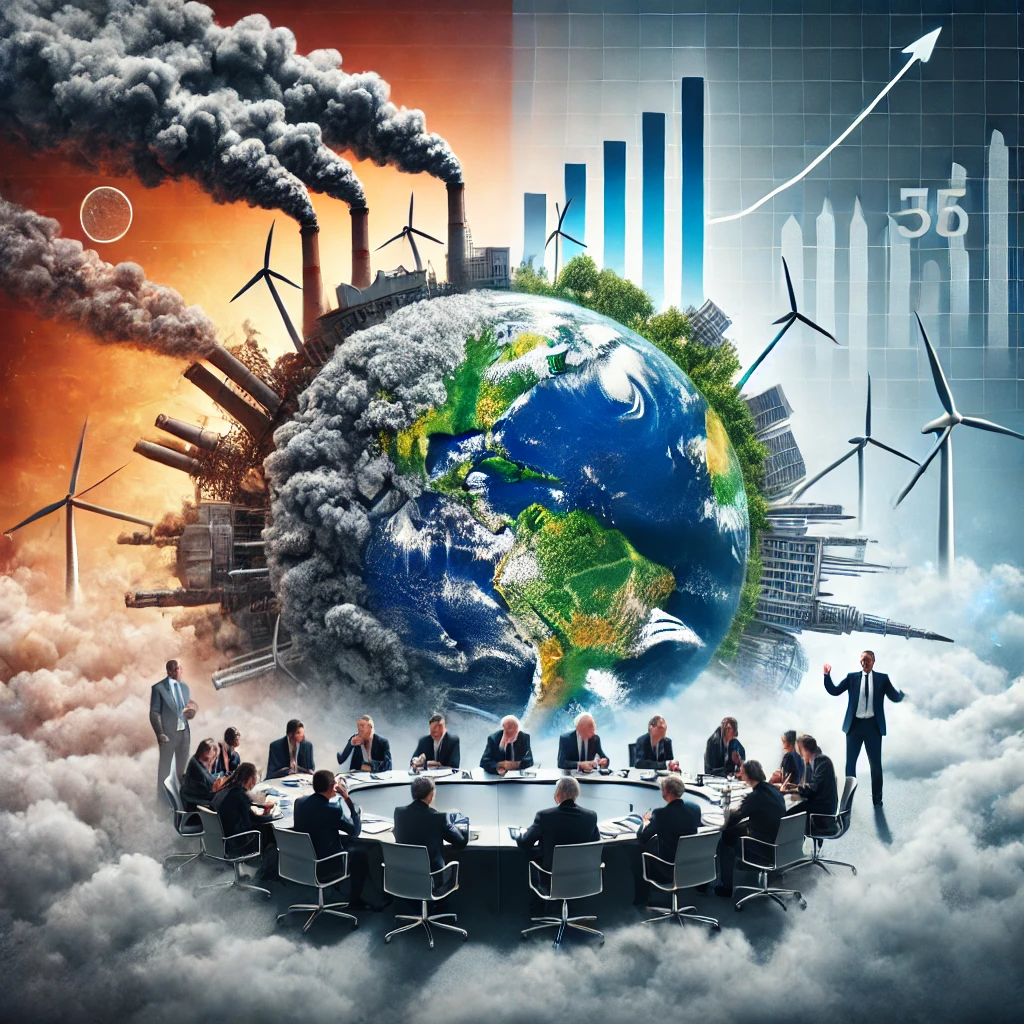Analyzing the Political Economy of Climate Change policies

The intersection of politics, economy, and climate change—balancing industrial growth, policy decisions, and environmental sustainability.
It has been witnessed that over the past decade Climate change has become a real threat rather than an abstract notion. The long-term alternation of the earth’s climate system by human activities now poses a direct threat to human security due to its domino effects. On one hand, the scale of harsh weather has grown and on the other hand, the catastrophic form of this harsh weather is also rising exponentially.
At the same time, notable progress also happened in the policy domain which is based on two main notions one is adaptation while the other is mitigation but both policies lag in implementation. The main reason behind these lags is the political cost attached to both policies, as well as the lack of coordination between states at the international level as the major power for instance U. S has withdrawn from both the Paris Agreement and Kyoto Protocol.
Moreover, Over the past few decades, many organizations have been working at local, national, and international levels to collaborate to reduce its consequences as well as to lower the emission of greenhouse gases. The most recent example of such an initiative is the “28th United Nations Climate Change Conference (COP28)” held in the U.A.E under the umbrella of “The United Nations Framework Convention on Climate Change (UNFCCC)” The COP28 concluded with an agreement that signals “the beginning of Fossil fuel era”.
Furthermore, the conference also emphasizes that there is a “need to advocate for loss and damage funds “and “invest more on adoption and pre-emptive measures ‘. Furthermore, COP28 also acknowledged the “Global Stocktake (GST)’ ‘ which appeals to reduce the emission of greenhouse gases by 43 percent till 2030 and also to limit the global warming(temperature)to 1.5°C.
While the “Political Economics of Climate Change” is a new domain that evolved recently, apprehending climate change from this perspective includes understanding both cost-benefit and incentives as well as comprehending the restrictions, power, interest, governance, and institution that shape resolution and action of different actors on climate crises. There are several challenges and opportunities linked with the political economy of climate change for instance, the political cost and benefit of these policies for leadership as well as the complexity and uncertainty that arise from diverse policy options.
In contemporary times as mentioned above, two main policies are used in the domain of political economics of climate change to deteriorate the frequency of climate change as well as to lessen the damages from climate catastrophes.
Climate Mitigation:
The first policy is known as “Climate Mitigation” which are action aimed at lessening the emission of greenhouse gases by enhancing the usage of renewable sources such as nuclear power, bioenergy, electric cars, and hydropower plants. In addition to these, it also emphasizes on enhancing “Carbon Sinks “which are reservoirs (natural or artificial) that store and absorb Carbon dioxide for instance land, atmosphere, oceans, and living organisms trees, and plants.
According to “The Centre for Climate and Energy Solution” the number of states that have adopted climate mitigation policies has now increased to 24 while the number of states that released action plans or are in progress to develop plans has reached 33. As mentioned above there are several political costs and benefits linked with each policy. The political cost of climate change mitigation is the following.
The first one is “Loss of popularity” as the policies can face public backlash when the public perceives it as costly, unfair, and ineffective. For example, when France introduced the “carbon tax” a widespread protest was ignited by the “yellow vests movement” against the government which challenged the legitimacy or popularity of the government. Second is the “loss of stability”’ these policies also generate a win-and-lose condition for the government by generating distributional conflict and social instability for example, when Germany introduced the “phase-out of coal policy in 2020 it faced opposition from the workers as well and western European states that depend on the coal industry.
Third is the “loss of competitiveness” these policies can also disturb the strategic interest of states, particularly if these policies are not synchronized with other states, for instance in 2017 the U.S withdrawal from Paris agreement due to the concern that this agreement could negative implication on U.S sovereignty and economy.
The political benefit of Climate mitigation policies is they will aid in “gaining the reputation” by improving the image as well as building a soft image of that state for example, the UK policy of “net-zero emission” enhances their Reliability to host COP26 summit in Glasgow. Secondly, it aids the state to “gain collaboration” with rival states like the U.S. and China giving a joint statement on the climate crisis in 2021. Lastly, these policies also assist the state to “gain resilience” by creating new avenues and innovations in different fields.
In addition to these certain factors influence the public support and opposition to these plans of action, like “perceived effectiveness, effects on disparities, industrial structure, and household wellbeing. Furthermore, states like Sweden have successfully implemented climate change mitigation policies while China seemed to have mixed performance and Australia failed due to the absence of social and political harmony.
Climate adaptation:
The second policy is known as the “Climate adaptation policy” which is a plan of action aimed at decreasing the adverse impacts of the climate crisis by lowering the vulnerabilities and enhancing resilience. Just like mitigation policies, there are certain political costs and benefits for a government that implements climate adaptation policies.
The political cost includes “Opportunities cost and trade-off” as the administration has to trade off certain other sectors and reallocate their funds to adaptation projects like constructing seawalls to reduce the rise of sea levels in coastal areas. Secondly, these policies can also generate “tension” between different groups and generate a zero-sum circumstance. For instance, shifting the climate-vulnerable communities to a haven may face opposition from the inhabitants resulting in conflict and controversies.
Lastly, the adaptation policies may be challenged by “reservation and Complication” which happens due to a lack of quality data. While the political benefits include “reduction in climate vulnerabilities” for instance planting early warning systems in the vulnerable zone aids in lowering the damage of climate catastrophes like floods. Secondly, it also assists states to “improve resilience” through innovation and development. Moreover, factors like vulnerabilities, resilience, risk perception, and effective governance influence the demand and supply in communities for adaptation measures.
Furthermore, many states adopted these policies but Bangladesh has successfully adopted these policies due to its political commitment harmony of interest between communities as well as awareness and sustainable innovation. Pakistan is a late entrant to these policies as it started its first “National Adaptation Plan” in 2021. Pakistan has faced numerous challenges limited resources high vulnerabilities, low adaptability, and weak governance. In the year 2022 due to a catastrophic flood, an estimated 33 million people were affected and the economic loss is more than $40 billion.
International Agreements on Climate Change:
There are certain global agreements and imitative taken to counter this borderless threat, some of them are “UNFCCC” which provides an agenda for international climate cooperation by arranging annual COPs for implementation evaluation. The credit for initiating” the loss and damage funds” also goes to UNFCCC as it is an outcome of COP27, LDF aims to provide financial assistance to stances suffering from climate catastrophes aid in reducing carbon emissions, and enhancing carbon sinks. The second most important agreement is the “Kyoto Protocol” It is the first legally binding agreement for emission reduction aims on developed states, the agreement faced servals challenges including U.S. withdrawal and inadequate participation from developed states.
Moreover, the second and current international agreement on climate change is the “Paris Agreement” These agreements aim to “limit the global temperature rise below 2°C, preferably to 1.5°C”. It introduced a voluntary approach to climate actions which are based on NDCs by all 189 parties. The Paris Agreement also faced challenges like the United States’ withdrawal and deficient NDC implementation.
Conclusion and Recommendations:
In summing up the above discussion the climate change has become a reality than an abstract nation, as it triggered massive human and economic loss. States have adopted various policies for climate action but in contemporary time two main policies are adopted by states, the climate mitigation and adaption. There are certain political cost and benefit for government are attached with each action states need to priories this cost and benefits.
Moreover, “political economy” has a very significant role in shaping effective climate policies, it assists to evaluate their policy implementation in both political and economic domain. It also provides some valid reason for why U.S has withdrawal from Paris agreement for instance due to its strategic and economic interest.
In addition to these analysts provides some recommendation for instance they argue that the climate change policies either mitigation or adaptation must view form a realistic approach for both political and economic factors.
Secondly there is need to balance the interest of different stakeholders involving in making and implementing climate actions both nationally and internationally. Thirdly there is need to more focus on mitigation policies rather than adaptation because of its long-term outcomes. Fourthly. Climate action policies must be unified and comprehensible with other policies and objectives, and should foster learning and partnership between different sectors and levels. Lastly the policies would also be flexible and adaptive to the diverse and uncertain environments, and it should improve its capacity and resilience of human and natural systems.



